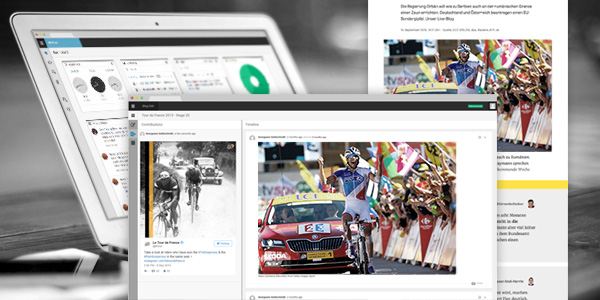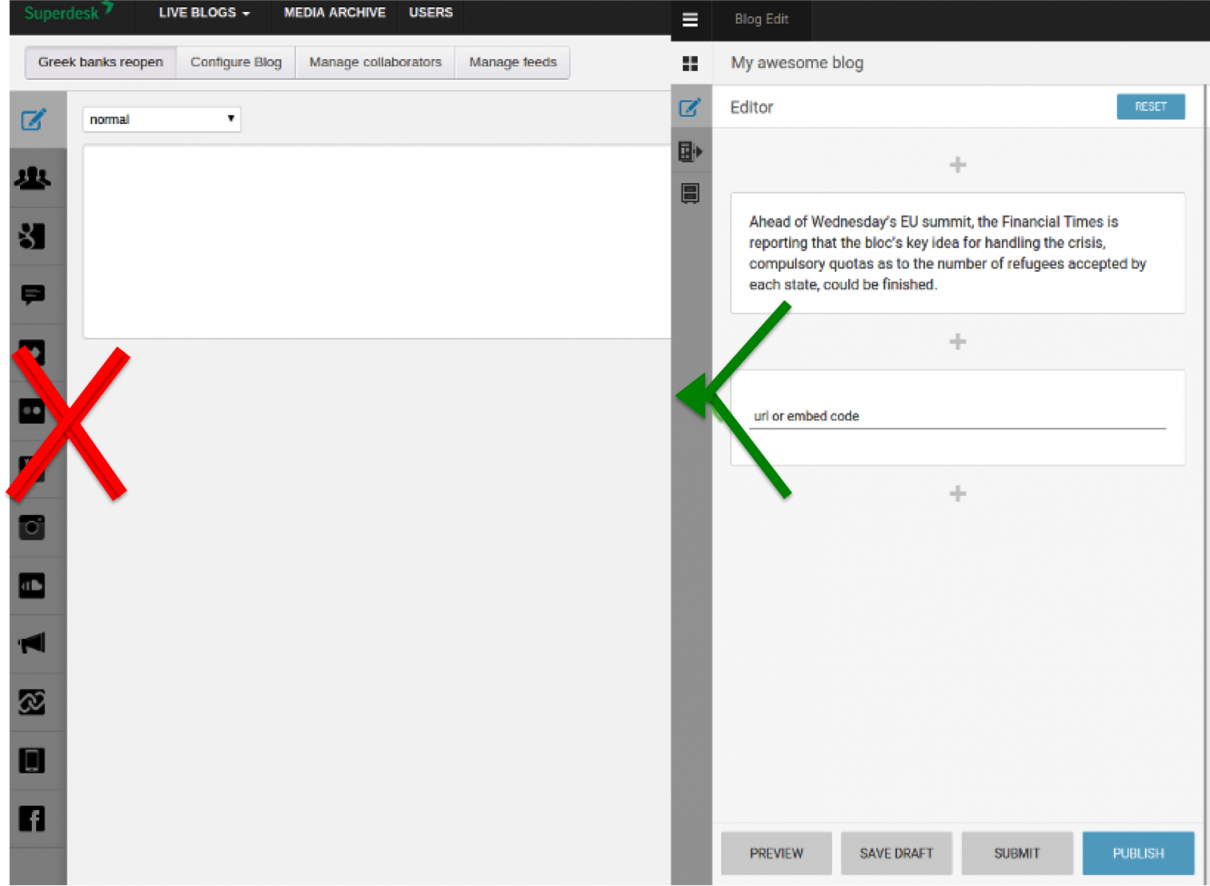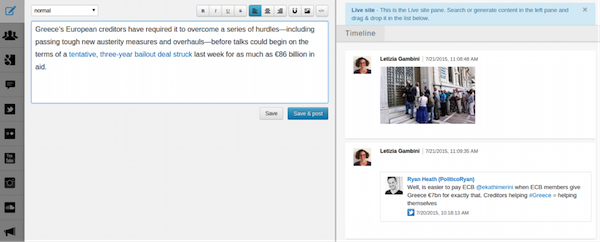The shift from Live Blog 2.0 to 3.0: everything you need to know

After a few months of development, Live Blog 3.0 beta is here at last. If you haven’t been following the progress, you can read more about the development in our previous post.
The beta release of 3.0 brings up some important questions about the differences between the 2.0 and 3.0 versions. If you have been following along, you know that 3.0 has close to nothing to do with the previous version. Technically, Live Blog 3.0 is an entirely different product than 2.0! You may be wondering why that is… and we’ve been getting a lot of questions. So we figured that with the release of Live Blog 3.0 beta, now was a good time to elucidate the matter. To see what’s new in 3.0, jump to the end of this post.
Superdesk and Live Blog 2.0
Live Blog 2.0 was originally developed on a version of Superdesk (Sourcefabric’s end-to-end news platform) that is not supported any longer. For different technical reasons, the Superdesk team decided not to go ahead with the first version of Superdesk, and especially a set of frameworks that were developed in house to provide the backbone of the project.
Sourcefabric is not developing the original version of Superdesk any further, not the frameworks anyway. Superdesk has now been rebuilt using an entirely different tech stack than the one used in that first attempt. This decision has represented a major booster for the Superdesk project as the team is now focused on developing actual features and not worrying about low-level complexities.
Nowadays Superdesk relies on well-known and proven open source frameworks and technologies which have brought enormous benefits (e.g. security, reliability, community support, etc.) and possibilities (e.g. service scalability, advanced capabilities, etc.) to the table.
The important thing is that we learned a lot and all of that is reflected in the new Superdesk and also in Live Blog 3.0.
The new Superdesk and Live Blog 3.0
So what’s so great about this new and improved version? Live Blog 3.0 uses Superdesk as a platform, it relies on the so-called Superdesk Core which provides all the underlying functionality, things like authentication, authorization, storage, users management, etc. What’s important is that Superdesk sets the blueprints for both the server and the client, allowing the Live Blog team to focus exclusively on live blogging features.
Alongside Live Blog, Sourcefabric is developing other journalistic applications on top of the new Superdesk such as a new web publishing system and an image verification tool. Our intention is to create a set of open source tools that integrate well to enable newsrooms to keep up with the lightning speed of change in the digital age.
Being a part of the ecosystem of Superdesk tools for journalism ensures that Live Blog will be ready to easily cope with the ever-changing digital news industry. In essence, Live Blog will be future-proof. Does this sound ambitious? Perhaps. But it’s also true. Live Blog is now a modern web application that scales well and can easily cope with the high demand of live news coverage.
Live Blog 2.0 vs Live Blog 3.0
As we said earlier, we learned a lot during the Live Blog 2.0 development process, most importantly, we learned a lot from our users. All that knowledge has been translated into new concepts and workflows in Live Blog 3.0. If you were a 2.0 user, here are some of the biggest practical changes you will see between the two versions.
Working with Social Media Content
In Live Blog 3.0 you will not find content sources as you did in 2.0.

The old toolbar in 2.0 on the left, the new simplified toolbar on the right in 3.0
Through feedback from our Live Blog editors, we found that they prefer to use either the original social media sites or specialized services to search for content instead of using the content sources provided in Live Blog 2.0. This is mainly because the search capabilities are far more advanced on each social media site. Additionally, maintaining those content sources in Live Blog 2.0 was very expensive for us and didn’t scale well.
Adding social media content in Live Blog 3.0 is now done by copying and pasting URLs (or embed codes) that you grab directly from each service. In Live Blog 3.0 we now rely on embed.ly, a very well known service that provides access to 200+ social media content providers.
Multi-Item Posts
In Live Blog, you build a live blog by putting together chunks of content. Every chunk is called a Post. In Live Blog 2.0 though, you were not able to combine posts, they were created one by one and rendered as clearly separated content blocks, as seen in the image below.

Content blocks in Live Blog 2.0
To allow for better storytelling, we have added support for multi-item posts in Live Blog 3.0. An Item is a unit of content which can be either a piece of text, an image, a quote or social media content (e.g. a tweet, an Instagram photo, a Vimeo video, etc.). You can build a Post by bundling as many items together as you wish to clearly state the relationship between them and better inform your readers. Creating single or multi-item posts is fairly simple in Live Blog 3.0, as seen in the following screenshot.

Multi-item post in Live Blog 3.0
Default Embed
Live Blog 2.0 offered two solutions for presenting live content to readers, one that made use of a Javascript embed and the so-called SEO embed, which is html rendered on the server and pushed to the clients. This has changed with this new Live Blog version. Live Blog 3.0 is shipped with an iframe output. We do not offer an SEO-friendly solution at the moment, but it will be available pretty soon, most likely with 3.1. The iframe output offers a few advantages compared to regular embeds, it is more portable and integrates with your website pages easily.
User roles
A few user rights have been added to user roles since the 2.0 version. Now only the blog owner and administrators can change blog settings.
New in 3.0
Lastly, here are some of our favorite brand new features you can expect in Live Blog 3.0.
Contributions
We have now enabled the distinction between editors and contributors in the content creation and management process. This feature is important as it allows contributors to create and submit posts that will be aggregated in a new tab called ‘Contributions’. Editors have the ability to decide what content gets pushed to the 'Timeline' from the selection of contributor's content in the ‘Contributions’ tab.

The new contributions tab in 3.0
Theme manager
In 3.0 you can expect an update to the ‘Theme manager’. It is now possible to remove a theme and to add or update a theme by uploading a zip file. We will be producing a guide for theme developers soon.
What does all of this mean for current 2.0 users?
Live Blog 2.0 is currently a supported version and Sourcefabric guarantees its maintenance for the near future. We are planning a transition to 3.0 which will begin happening as soon as the new version is ready and in a state to take over, not before. We will communicate this information to our users accordingly. In the meantime you can check out our Live Blog manual for journalists.
We’d like to thank to all the people both from within our organisation and externally who tested and provided feedback during the alpha phase. You rock! We appreciate your input, it helped us tremendously. Be sure to share your thoughts and feedback with us using our Facebook page, Twitter or via email. We’d like to hear from you.
Are you interested in trying out Live Blog? Email us to request a free trial from our support team. Want to stay up to date? Sign up for our Live Blog newsletter and get the latest updates sent directly to your inbox.
